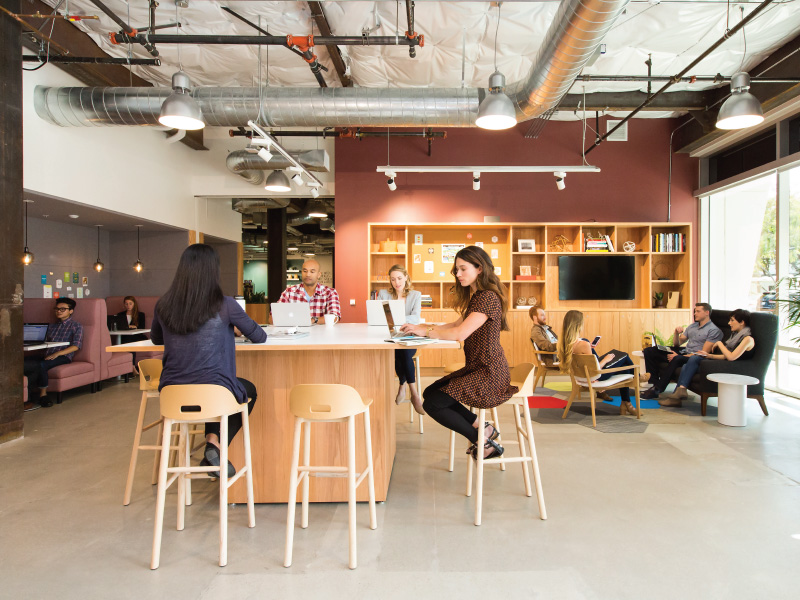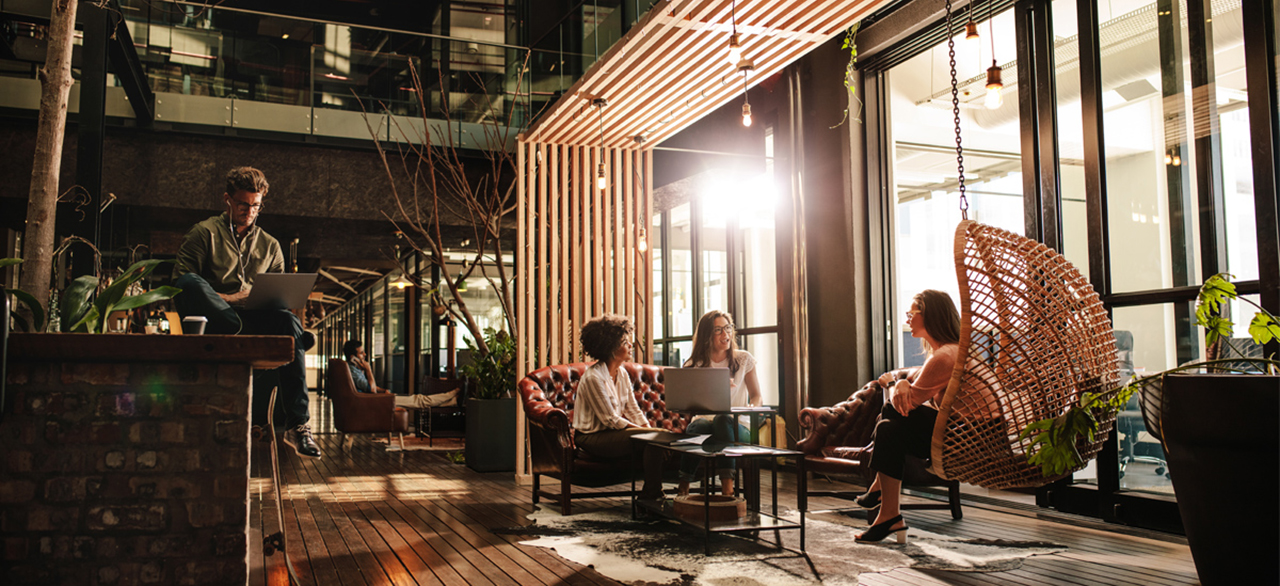JLL’s Bernice Boucher offers some strategies that can help you improve agility while delivering a unique employee experience.
Rapid technological advancement is changing when, where and how we work—whether a company is ready for it or not. Nothing stands still in the Fourth Industrial Revolution, so how we work must be dynamic and flexible to keep up with the speed of technological change and new generational expectations. No wonder flexible space—including short-term leased spaces and in-house community areas—has grown by 23 percent annually since 2010, with no signs of slowing. The trend has fundamentally changed the office market and the concept of “workplace.”
Flexible strategies ensure that a company can achieve agility overdrive: nimble in its approach to technology, enterprise strategy, talent and real estate. The rapid growth of flexible space options means that companies now have a robust menu to choose from—everything from onsite community spaces and incubators to home offices or coworking spaces—to empower employees to be most productive.
Giving employees greater control over how and where they work builds flexibility into an office’s and company’s DNA. And, employees are clamoring for this kind of flexibility. More than half of employees, 51 percent, want their companies to offer more flexible work options, according to Mercer’s Global Talent Trends study.
But flex space looks different in every location, for every office culture. So, despite the wealth of options, many companies struggle to find the right flexible space for their needs. Enter the custom-fit flex space. It’s possible to bring the best of coworking to your portfolio while creating a tailored workplace—without the long-term commitment of a traditional office.
Flex space unchains employees from their desks, so they can work where and when it makes sense. Tailored amenities and concierge services help shape a meaningful and unique employee experience, regardless of where they work. Flex makes it possible to bring the office to the talent, rather than the other way around. Short-term leases and coworking options make it possible to open offices quickly where talent prefers to work.
But winning the war for talent is about more than amenities, encompassing location, technology and emotional connection. Companies need to deliver amazing, engaging and agile workplaces that keep pace with changing employee preferences. Winning the war for talent means moving rapidly, considering all marketplace options, and being armed with the right data to inform decisions.
The following strategies can help you improve agility while delivering a unique employee experience.
Hospitality-style amenities on the rise
Just as HGTV raised the bar for home design, Instagram and “cool office” rankings have heightened employee expectations for the workplace. The rise in hospitality-style amenities manifests in everything from fitness and wellness offerings and convenience services, such as dry cleaning and pet- or childcare, beer and wine experiences, stunning lounges and networking opportunities. These perks deliver more than a superficial “wow factor”—occupiers provide these more vibrant office settings to recruit and retain talent; boost employee happiness and productivity; and enhance collaboration.
Employees want to feel at home in the office and, just as important, they want the power to choose the chair, standing desk or other seat where they feel most comfortable and productive.
Today’s employees are growing accustomed to greater choice and autonomy at work—45 percent of U.S. workers have choice in where they work within their office, according to Gensler’s U.S. Workplace Survey 2019. And, offering employees options has real impact: 79 percent of people in workplaces with a variety of settings report a great experience. In contrast, only 33 percent of employees who lack a variety of settings report a great experience.
Offering a variety of spaces to support in-office mobility is clearly important, but how do you know which work settings you need? There’s no easy answer to that question. The right workspaces and amenities for each organization depend on the demographics of the workforce and the type of work they do. Even within the same organization, what works in Pittsburgh may not cut it for Silicon Valley employees, or vice versa.
A curated mix of amenities should carefully consider the needs of your employees and the spaces they need to be most effective. An organization may need maker spaces, innovation hubs, game lounges, meditation rooms, phone booths, focus rooms, in-house cafes or many other options. Space utilization data can provide valuable insight into which amenities are in high demand and which spaces sit empty, allowing you to tweak the mix as needed.
Concierge services to lessen the load of 24/7 work weeks
Mobile technology has changed the nine-to-five, Monday-Friday work week to a 24/7 culture where employees feel pressured to be on all the time. Everyone is busy, it seems, so employers can make a big difference in employees’ daily lives with concierge services that lighten the burden. From car detailing to dry cleaning pickup, employees appreciate services that strike tedious tasks from their never-ending to-do lists.
Concierge services are a common (and enticing) feature of coworking spaces, and can be part of your custom flex space, too. Next-generation workplaces respond employee needs, So, if you’re looking to create a unique employee experience in your space, consider a customer service-oriented concierge staff that will anticipate those needs.
Workplaces must transform into buzzing communities integrating work, live and play
One appeal of coworking spaces is that they come with a built-in community. You can replicate that model in your own workplaces by bringing on board workplace ambassadors and community managers who embrace employee happiness as their number one priority.
Even the best-designed space will fail to meet your human experience goals if you don’t take the steps needed to bring people together. That’s where community managers can make a big impact. Programs like early-morning yoga, lunchtime book clubs and happy hours provide opportunities for employees to socialize and expand their networks within the organization. An ambassador program, meanwhile, helps support talent retention by ensuring all employees feel at home in their space and understand where to find assistance with workplace needs.
The key to any community management program is to tailor it to your unique culture. Do your employees put their heart into competitive sports or prefer more low-key activities? Are they sprinting out the door at the end of the day to have dinner with their family or do they like to grab a drink with office mates after work? If you work for a large company, chances are you might answer “all of the above,” and you’ll need your community manager to cater to the many subcultures within your organization.
Digitized spaces bring personal tech convenience to the workplace
Flexible space is more effective when employees have the right technology at their fingertips to be mobile, navigate the space and get the support they need. Wiring the office for mobility, for example, ensure that employees can access power and WiFi wherever they are in the building. Mobile workers thrive with cloud-based tech designed to offer comfort, convenience and productivity.
However, a truly digitized space goes beyond basic connectivity. Advances in consumer technology have changed what employees expect in their workplace. If they can adjust the temperature or turn on the lights with an app at home, shouldn’t the workplace offer the same convenience?
In response to employee questions about how to book a workspace, find a colleague or ordering catering, more organizations today are responding with “there’s an app for that.” When McDonald’s opened its new smart headquarters in downtown Chicago, for example, the company also launched a custom mobile app to help employees and visitors navigate the building.
A lease built for flexibility
One appeal of coworking is that a company can quickly scale up or down space with short-term membership agreements as its workforce expands and contracts. That option may be ideal for some companies with a highly mobile workforce or other specialized needs. Yet, it’s not the only option for companies seeking flexibility.
In today’s environment of constant disruption, workplaces change more frequently than ever. Landlords are catching up to this new reality with greater openness to shorter leases. If you’re seeking swing space or have project teams with highly variable needs, a short-term lease may be a good way to get a personalized office without a long-term commitment. An experienced real estate partner can help you negotiate a short-term lease with the most favorable terms for your organization, bringing more agility to your portfolio.
Custom-fit flex spaces offer the best of both worlds
The “on-demand” economy has been driven by consumer expectations, and those expectations have now reached the workplace. When a business needs more space quickly, whether for swing space during a build-out or renovation or a satellite office in a new market, flex spaces can help balance the need for speed with requirements for a branded, secure space. By using preconfigured designs and furniture standards, flex spaces can be built out quickly, while still allowing for customization.
The war for talent is only going to get more competitive—and flexibility and agility have never been more important than in today’s environment of rapid and constant disruption. Moving forward, companies will need to deliver amazing, engaging and agile workplaces that keep pace with changing employee preferences and technologies. Winning the war for talent means moving rapidly, considering all marketplace options, and being armed with the right data about your workforce to create an exceptional and unique employee experience for all.
Coworking providers have upped the ante for what employees expect in a workplace, but they’ve also introduced many great ideas for how to keep people happy. With the growing availability of flex space options and strategies, you can bring the best of coworking to your portfolio for the people who matter most—your talent.






Thanks for the article Bernice. We not only support the architectural and design community in division of space, but we are always looking at ways to bring those same benefits to our own offices and employees. Your article is great to capture it from the individual perspective on a much larger scale. Thanks Bernice!